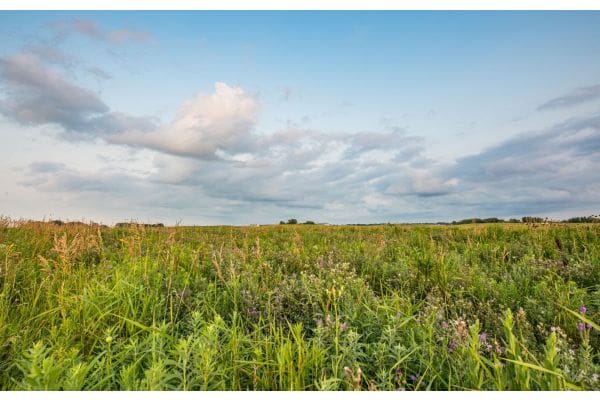Advocates for Grassland Act Welcome New Conservation Tool

Science-based project demonstrates the need for legislation aimed at conserving America’s prairies, savannas, glades, and sagebrush
Today, a coalition of conservation organizations is celebrating the launch of MapforGrasslands.Org as illustration of the need for the North American Grasslands Conservation Act. The first-of-its-kind website documents the loss of grasslands in North America, the subsequent impact on iconic wildlife species, and the need for grasslands-specific legislation – the North American Grasslands Conservation Act (Grasslands Act) – to address upland habitat loss.
The new website demonstrates the significant loss of America’s prairies, savannas, glades and sagebrush over a thirty-year period (1992-present). Fifteen individual species are also highlighted within the project, showcasing population declines in some of America’s iconic wildlife — including the northern bobwhite quail, monarch butterfly, and bobolink. Produced by Cornell Lab of Ornithology in collaboration with the coalition, the project is a valuable tool for legislators, hunters, and conservationists to better understand the habitat and species loss in their own backyards while empowering individuals to act.
“Grasslands across the U.S., and the species that call them home, are suffering dramatic losses. To deliver the message of grasslands in trouble and inspire action, we saw the need to show in one place all these losses, using the most authoritative evidence available,” said Wenfei Tong, a Science Editor at the Cornell Lab of Ornithology. “The value of this tool is that it summarizes published data to show the link between large-scale biodiversity declines and the loss of our native grasslands.”
“The Map for Grasslands tool really demonstrates the magnitude of grasslands habitat loss across the country and how those lost ecosystems have had devasting impacts on the birds, insects, mammals, and even the fish species living there,” stated Pheasants Forever and Quail Forever President & CEO Marilyn Vetter. “It’s a great example of how science can help make the case for critically important Grasslands Act legislation.”
“It’s hard to imagine the massive loss of grasslands across our enormous prairie ecosystems, but with Map for Grasslands, now we can see it,” said Ted Koch, Executive Director for the North American Grouse Partnership. “Over two centuries we went from unending ‘seas of grass’ with teeming wildlife like prairie grouse, to postage-stamp grasslands and increasingly endangered species. Americans have saved other endangered ecosystems before. Now it’s time to save prairies with the North American Grasslands Conservation Act.”
“Grasslands are North America’s most imperiled ecosystem. This mapping tool affirms that we need to take concerted, collaborative steps to conserve and restore this landscape, which is essential for wildlife, water, and our way of life throughout the country,” said Aviva Glaser, Senior Director of Agriculture Policy at the National Wildlife Federation. “We need our leaders to rally around solutions like the North American Grasslands Conservation Act to ensure this great American landscape endures for future generations.”
“With more than 1.5 million acres of vital grassland habitat being lost to the plow each year, we’re trending in the wrong direction. The Map for Grasslands tool clearly illustrates how the current rate of grasslands destruction not only harms wildlife, but our own health and well-being too,” said Martha Kauffman, Vice President for the Northern Great Plains Program, World Wildlife Fund-US.
“All wildlife rely on healthy habitat to thrive – from grasslands to forests – and arming landowners with the resources to conserve and manage habitat is vital for wildlife,” said Ben Jones, President and CEO of the Ruffed Grouse Society and American Woodcock Society.
“Millions of acres of grassland and sagebrush habitat is rapidly disappearing across the North American landscape, a loss of critical habitat impacting a broad assemblage of species including pronghorn and bobwhite quail,” said Patrick Berry, President and CEO of Backcountry Hunters & Anglers. “When coupled with meaningful policies like the North American Grasslands Conservation Act, innovative resources like the Map for Grasslands will help inform identification of strategic projects to conserve these shrinking landscapes.”
The Grasslands Act is modeled upon the very successful North American Wetlands Conservation Act (NAWCA) to empower America’s landowners with voluntary conservation tools to help conserve these grasslands, prairies, savannas, and sage lands. This program would live within the U.S. Department of Interior and complement the Farm Bill programs within USDA. Like NAWCA, the coalition is seeking the Grasslands Act to be authorized at $60M annually, with an increase of $7.5M/year.
In July of 2022, America’s leading conservation groups touted the introduction of the Grasslands Act by U.S. Senator Ron Wyden of Oregon — co-sponsored by U.S. Senator Amy Klobuchar of Minnesota and U.S. Senator Michael Bennet of Colorado. Coalition partners are currently working with elected officials on revised bill language in hopes of reintroduction for the future.
To learn more about the North American Grasslands Conservation Act or to take action on behalf of this historic legislation, please visit www.ActforGrasslands.Org.
About Pheasants Forever and Quail Forever
Pheasants Forever and Quail Forever make up the nation’s largest nonprofit organization dedicated to upland habitat conservation. This community of more than 420,000 members, supporters and partners is dedicated to the protection of our uplands through habitat improvement, public access, education and advocacy. A network of 754 local chapters spread across North America determine how 100 percent of their locally raised funds are spent — the only national conservation organization that operates through this grassroots structure. Since its creation in 1982, the organization has dedicated more than $1 billion to 580,000 habitat projects benefiting 26.5 million acres.
The post Advocates for Grassland Act Welcome New Conservation Tool appeared first on HuntingLife.com.
